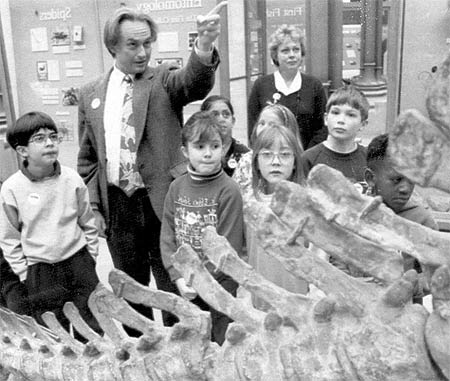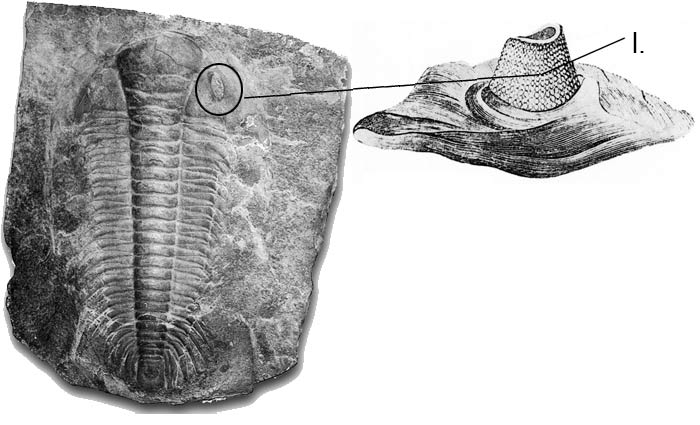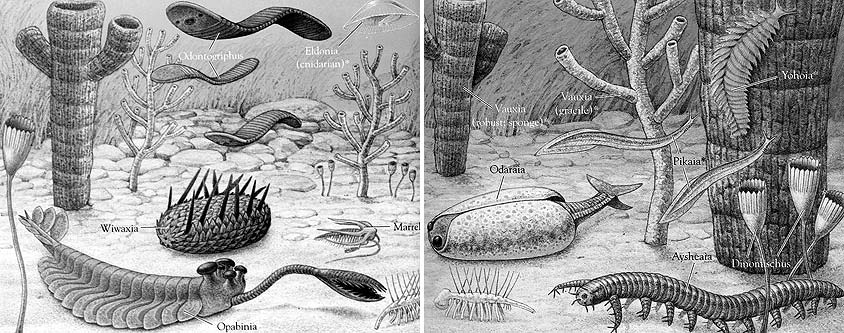Investigation of the geological strata and the fossil record shows that life on Earth emerged all of a sudden. The deepest stratum in which fossils of living things are encountered is that known as the Cambrian, dating back 520 to 530 million years.
The fossils in Cambrian rocks belong to radically different life forms. What comes as a terrible disappointment to evolutionists is that all of these species emerged suddenly and with no primitive forerunners preceding them.
Most of the life forms in Cambrian strata possess complex systems, such as eyes, gills and blood circulatory systems, and often, advanced physiological features no different from those of creatures living today. This is a sign that all of life was created in a single act, with no common ancestors or evolutionary process being involved.
Darwin warned that if such a possibility were ever proven-that life began suddenly-it would represent a lethal blow to this theory. As can be seen from the evolutionist statements below, the theory of evolution suffers the first of many such blows from the Cambrian fossils, among the earliest forms of life.
As the Harvard paleontologist and evolutionist Stephen Jay Gould has said, Darwinists’ greatest alarm stems from the fossil record, and particularly from Cambrian fossils:
The fossil record had caused Darwin more grief than joy. Nothing distressed him more than the Cambrian explosion, the coincident appearance of almost all complex organic designs.155
Charles Darwin:
If numerous species, belonging to the same genera or families, have really started into life all at once, the fact would be fatal to the theory of descent with slow modification through natural selection.156
For instance, I cannot doubt that all the Silurian trilobites have descended from some one crustacean, which must have lived long before the Silurian age, and which probably differed greatly from any known animal... Consequently, if my theory be true, it is indisputable that before the lowest Silurian stratum was deposited, long periods elapsed, as long as, or probably far longer than, the whole interval from the Silurian age to the present day; and that during these vast, yet quite unknown, periods of time, the world swarmed with living creatures. To the question why we do not find records of these vast primordial periods, I can give no satisfactory answer.157
Niles Eldredge is a paleontologist at Harvard University:
Then there was something of an explosion. Beginning about six hundred million years ago, and continuing for about ten to fifteen million years, the earliest known representatives of the major kinds of animals still populating today's seas made a rather abrupt appearance. This rather protracted 'event' shows up graphically in the rock record: all over the world, at roughly the same time, thick sequences of rocks, barren of any easily detected fossils, are overlain by sediments containing a gorgeous array of shelly invertebrates: trilobites (extinct relatives of crabs and insects), brachiopods, mollusks. Indeed, the sudden appearance of a varied, well-preserved array of fossils, which geologists have used to mark the beginnings of the Cambrian Period (the oldest division of the Paleozoic Era) does pose a fascinating intellectual challenge.158
No wonder paleontologists shied away from evolution for so long. It never seemed to happen. ... When do we see the introduction of evolutionary novelty, it usually shows up with a bang... Evolution cannot forever be going on somewhere else. Yet that’s how the fossil record has struck many a forlorn paleontologist looking to learn something about evolution.159
Daniel Axelrod is professor of geology and botany at the University of California:
One of the major unsolved problems of geology and evolution is the occurrence of diversified, multi-called marine invertebrates in the lower Cambrian rocks on all the continents and their absence in rocks of greater age.160
 |
| The evolutionist Richard Dawkins indoctrinating young students with evolutionary propaganda. |
Barbara Jaffe Stahl is an evolutionist paleontology professor and senior faculty member at Saint Anselm College, Manchester:
Finding vertebrate bone in Cambrian rocks, for instance, has proved that the back-boned animals are as old as most of the known invertebrates.161
Richard Monastersky is senior writer at The Chronicle of Higher Education in Washington:
A half-billion years ago,... the remarkably complex forms of animals we see today suddenly appeared. The Chengyiang fauna demonstrates that the large animal phyla of today were present already in the early Cambrian and that they were as distinct from each other as they are today.162
Richard Dawkins is a British zoologist and one of the leading contemporary evolutionists:
For example the Cambrian strata of rocks... are the oldest ones in which we find most of the major invertebrate groups. It is as though they were just planted there, without any evolutionary history.163
Stephen Jay Gould is professor of geology and paleoanthropology at Harvard University:
Where, then, are all the Precambrian ancestors-or, if they didn't exist in recognizable form, how did modern complexity get off to such a fast start?164
The Cambrian explosion was the most remarkable and puzzling event in the history of life.165
American paleobiologist J. William Schopf:
The long-held notion that Precambrian organisms must have been too small or too delicate to have been preserved in geological materials… [is] now recognized as incorrect.166
 |
| 1. Combed Eye The trilobite pictured to the left is a life form that emerged some 530 million years ago, in the Cambrian Period, and has since become extinct. Trilobites had extraordinarily complex eyes. These, consisting of hundreds of comb-like components and a double-lens structure, are a miracle of creation that leaves evolutionists speechless. The sudden appearance of such a structure in the fossil record is one of the manifest proofs that refute the theory of evolution. |
According to Berkeley paleontologist James Valentine and his colleagues:
The explosion is real, it is too big to be masked by flaws in the fossil record… even more abrupt and extensive than previously envisioned.167
David M. Raup is a paleontologist at the University of Chicago:
The major subgroups appear early and at about the same time… Nearly all living phyla of marine invertebrates that have reasonably good fossil records have first occurrences either in the late Precambrian or early to middle Cambrian. At the class level there are 27 paleontologically important living groups and all have documented occurrences which are Silurian or older…The same relative pattern can be seen in the geologic records of vertebrates and land plants.168
Niles Eldredge is curator in the division of paleontology of the American Museum of Natural History:
There is still a tremendous problem with the sudden diversification of multi-cellular life. There is no question about that. That's a real phenomenon.169
Most families, orders, classes, and phyla appear rather suddenly in the fossil record, often without anatomically intermediate forms smoothly interlinking evolutionarily derived descendant taxa with their presumed ancestors.170
Darwin confesses in his own book The Origin of Species: To the question why we do not find rich fossiliferous deposits belonging to these assumed earliest periods prior to the Cambrian system, I can give no satisfactory answer. … The case at present must remain inexplicable; and may be truly urged as a valid argument against the views here entertained.171
 |
| Snails, sponges, worms, sea anemones, starfish, swimming crustaceans and sea urchins, some of the life forms that suddenly emerged in the Cambrian Period, possess exactly the same perfect structures as their counterparts living today. |
From a pro-Darwinist text book:
Most of animal phyla that are represented in the fossil record first appear, “fully formed,” in the Cambrian some 550 million years ago... The fossil record is therefore of no help with respect to the origin and early diversification of the various animal phyla.172
Ernst Mayr was one of the leading evolutionary biologists of the twentieth century:
New species usually appear in the fossil record suddenly, not connected with their ancestors by a series of intermediates.173
Marshall Kay is a geologist and professor at Columbia University and Edwin H. Colbert is an authority on paleontology and curator at the American Museum of Natural History:
The introduction of a variety of organisms in the early Cambrian, including such complex forms of the arthropods as the trilobites, is surprising... Why should such complex organic forms be in rocks about six hundred million years old and be absent in the records of the preceding two billion years?.. If there has been evolution of life, the absence of the requisite fossils in the rocks older than the Cambrian is puzzling.174
Of course the absence of any fossils in rocks older than the Cambrian is baffling to Darwinists, because this is one of the most obvious and certain pieces of evidence that no such fictitious process as evolution ever happened. A Darwinist can deny it all he likes, but he will definitely have seen the invalidity of evolution in the face of this clear and magnificent evidence. Indeed, the way that Charles Doolittle Walcott, a paleontologist and founder of the Simthsonian Institute and who first discovered Cambrian fossils, panicked in the face of this clear evidence that totally undermined evolution and kept these fossils hidden away for seventy years is manifest confirmation of this. (For detailed information, see The Cambrian That Darwin Did Not Understand, by Harun Yahya)
155- Stephen J. Gould, The Panda's Thumb, 1980, p. 238-239
156- Charles Darwin, The Origin of Species: A Facsimile of the First Edition, Harvard University Press, 1964, p. 302.
157- Ibid., pp. 313-14.
158- N. Eldredge, The Monkey Business: A Scientist Looks at Creationism (1982), p. 44.
159- Niles Eldredge, Reinventing Darwin: The Great Debate at the High Table of Evolutionary Theory, John Wiley & Sons, 1995, p. 95
160- D. Axelrod, Science, 128.7, 1958
161- Barbara J. Stahl, Vertebrate History: Problems in Evolution, New York: Dover Publications, 1985, p. vii
162- Richard Monastersky, "Mysteries of the Orient," Discover, April 1993, p. 40
163- Richard Dawkins, The Blind Watchmaker, W. W. Norton, London, 1986, p. 229.
164- Stephen Jay Gould, "A Short Way to Big Ends", Natural History, vol. 95 (Jan 1986), p. 18
165- Stephen Jay Gould, "The Evolution of Life on Earth", Scientific American, vol. 271 (October 1994), p. 89
166- J. William Schopf, "The early evolution of life: solution to Darwin's dilemma," Trends in Ecology and Evolution 9 (1994): 375-377.
167- James W. Valentine, Stanley M. Awramik, Philip W. Signor & M. Sadler, "The Biological Explosion at the Precambrian-Cambrian Boundary," Evolutionary Biology 25 (1991): 279-356.
168- David M Raup, “On the early origins of major biologic groups,” Paleobiology, Spring 1983, p. 107.
169- Niles Eldredge, quoted in Darwin's Enigma: Fossila and Other Problems by Luther D. Sunderland, Master Book Publishers, Santee, California, 1988, p 45
170- Eldredge, N., 1989, Macro-Evolutionary Dynamics: Species, Niches, and Adaptive Peaks McGraw-Hill Publishing Company, New York, p. 22
171- Charles Darwin, The Origin of Species: A Facsimile of the First Edition, Harvard University Press, 1964, p. 350-351.
172- R.S.K. Barnes, P. Calow and P.J.W. Olive, The Invertebrates: A New Synthesis, pp. 9–10, 3rd ed., Blackwell Sci. Publications, 2001.
173- Ernst Mayr: What Evolution Is, pg. 189 (Basic Books, 2001).
174- Kay, Marshall, and Edwin H. Colbert, Stratigraphy and Life History, 1965, 736 pp. 102-103